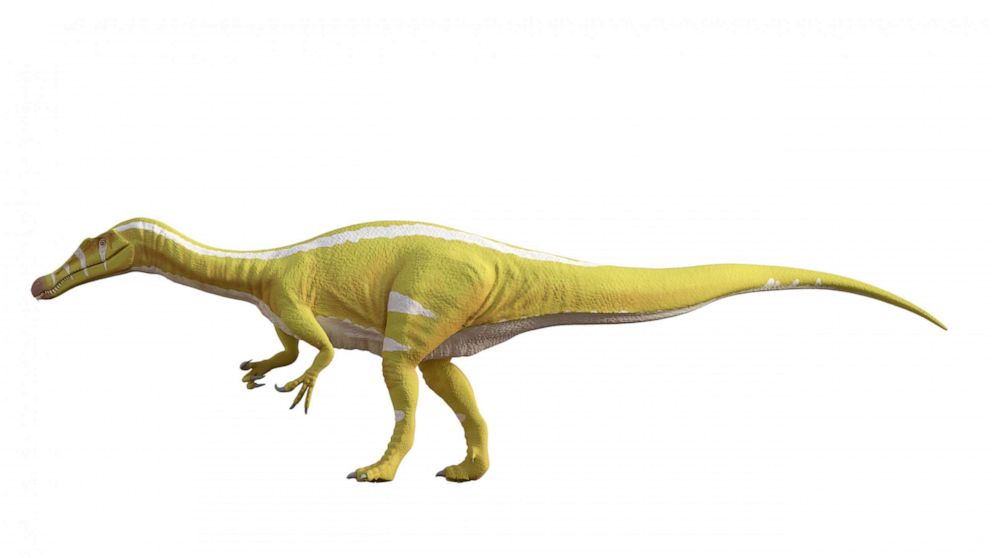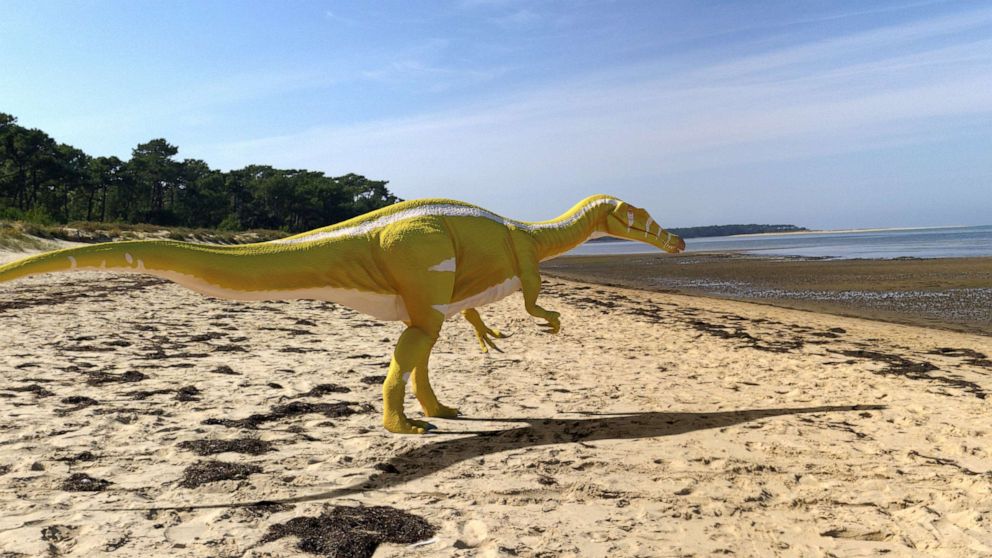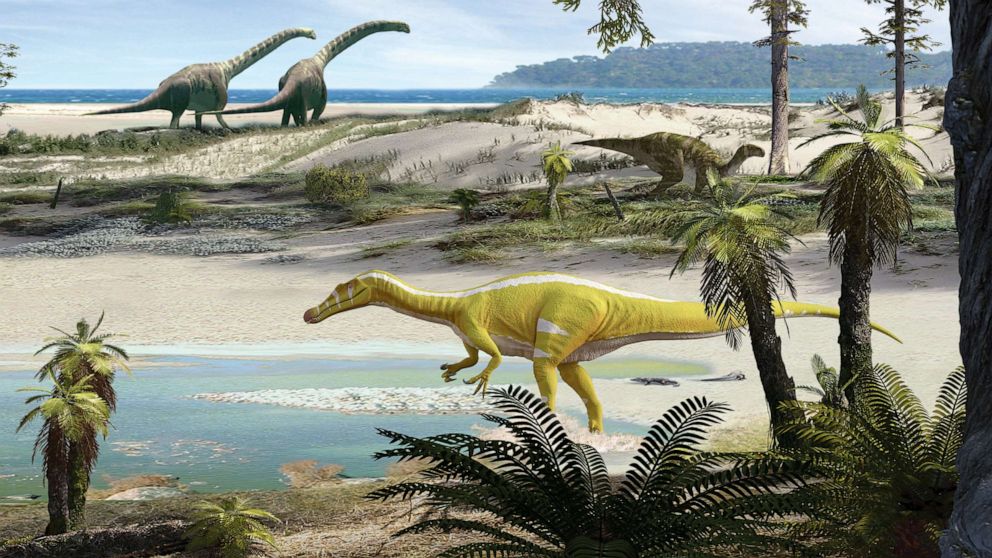Paleontology: Fossil fragments shed light on a new spinosaurid dinosaur in Spain
A dinosaur specimen from Castellón, Spain represents a new proposed species of spinosaurid, reports a paper published in Scientific Reports. The identification of a potential new species suggests that the Iberian peninsula may have been a diverse area for medium-to-large bodied spinosaurid dinosaurs and sheds light on the origin and evolution of spinosaurids.
Spinosaurids comprise of different groups of dinosaurs that are often large, stand on two feet, and are carnivorous. Well-known examples of spinosaurids include Spinosaurus and Baryonyx. It is thought that spinosaurids may have originated in Europe and then migrated to Africa and Asia, but evidence of their existence in Spain is mostly based on fossilised tooth remains.
Andrés Santos‑Cubedo and colleagues analysed fossil fragments (a right jaw bone, one tooth and five vertebrae) discovered previously in the Arcillas de Morella Formation in Spain and dated to the late Barremian, Early Cretaceous period (between 127 and 126 million years ago). Based on the remains the authors estimate that the specimen is around 10 to 11 metres long. They compared the specimen to data on other spinosaurids to determine its evolutionary relationship to other species.
Based on a comparative analysis of the specimen with other spinosaurids, the authors identified the specimen as both a new species and a new genus of spinosaurid and named it Protathlitis cinctorrensis. The authors named the genus Protathlitis meaning “champion” in Greek and used cinctorrensis in the species name to reference the town — Cinctorres — in which the specimen was uncovered.
The authors propose that this new species may indicate that spinosaurids appeared during the Early Cretaceous in Laurasia — a large area of land in the northern hemisphere — with two sub-groups of species occupying western Europe. The spinosaurids may have later migrated to Africa and Asia where they diversified. In Europe, baryonychines like Protathlitis were dominant, while in Africa, spinosaurines like Spinosaurus were most abundant.
###
Article details
A new spinosaurid dinosaur species from the Early Cretaceous of Cinctorres (Spain)
DOI: 10.1038/s41598-023-33418-2
Please link to the article online https://www.nature.com/articles/s41598-023-33418-2
JOURNAL
Scientific Reports
DOI
New dinosaur, a species of spinosaurid,
discovered in Spain, researchers say
The dinosaur stood on its hind legs and captured prey with its hands.
ByJulia Jacobo
May 18, 2023,
2:53
One of the world's biggest-ever new dinosaur species found
Scientists dig up a gigantic new dinosaur species as long as a basketball court in Australia's outback
Fossil fragments found in Spain are pointing to a new species of dinosaur, researchers said.
Scientists have proposed a new species of spinosaurid after studying the specimen, which includes a right jaw bone, one tooth and five vertebrate, found in the Arcillas de Morella Formation in Castellon, Spain, in 2011, according to a study published in Scientific Reports on Thursday.

A new spinosaurid dinosaur, Protathlitis cinctorrensis, was discovered in Spain.
Grup Guix
Spinosaurids are often characterized by their large bodies, which stand on two feet. The group of dinosaurs, which include the Spinosaurus and Baryonyx, are also typically carnivorous.
MORE: Scientists discover fossils of new predatory dinosaur species in Mongolia
The fossils date to the late Barremian or Early Cretaceous period -- between 127 million and 126 million years ago, the authors said. Based on the remains, the researchers believe the dinosaur was between 10 meters to 11 meters long, or about 32 feet to 36 feet.
After comparing the specimen to other spinosaurids, the researchers determined it as both a new species and a new genus of spinosaurid, naming it Protathlitis cinctorrensis, with Protathlitis meaning "champion" in Greek and "cinctorrensis" in honor of the town, Cinctorres, in which the fossils were uncovered, according to the study.

A new spinosaurid dinosaur, Protathlitis cinctorrensis, was discovered in Spain.
Grup Guix
The name "Champion" was in reference to the UEFA Europa League title won by European soccer club Villarreal C.F. in 2021 and to celebrate the club's 100th anniversary in 2023, lead researcher Jose Santos‑Cubedo told ABC News.
Protathlitis cinctorrensis also has an elongated snout fitted with numerous conical teeth and used their hands to capture prey, Santos‑Cubedo said.
MORE: Giant, meat-eating new dinosaur species discovered in Argentina
The finding suggests the Iberian peninsula may have been a diverse area for medium to large-bodied spinosaurid dinosaurs, shedding further light on the origin and evolution of the type of dinosaur.
It is believed that spinosaurids may have originated in Europe and then migrated from Africa to Asia, according to the paper. Evidence of their existence in Spain is mostly based on fossilized tooth remains.

A new spinosaurid dinosaur, Protathlitis cinctorrensis, was discovered in Spain.
Grup Guix
The researchers believe this new species may indicate that spinosaurids appeared during the Early Cretaceous period in Laurasia -- a large area of land in the northern European hemisphere -- with two sub-groups of species occupying western Europe, according to the paper.
MORE: 2 new species of massive sauropod dinosaurs found in China, a 1st for the region
The spinosaurids may have later migrated to Africa and Asia, where they diversified.

A new spinosaurid dinosaur, Protathlitis cinctorrensis, was discovered in Spain.
Oscar Sanisidro/Grup Guix
"In Europe, baryonychines were dominant, while in Africa, spinosaurines were the most abundant," Santos‑Cubedo said.
No comments:
Post a Comment